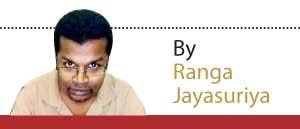A Separate Common Tamil Presidential Candidate: A Dangerous Gamble
Northern Tamil elites always had a problem. It is not just a gripe with the successive Sinhalese-dominated governments that have ruled since independence. The problem is more fundamental. It is about reconciling with the existential realities of the demographic composition of the country and the corresponding distribution of power. The ‘incestual’ circuit of NGO captains and root learning academics would blame that on discrimination. However, an objective analysis would reveal this as a function of the Dravidian ethnic political nationalism.
governments that have ruled since independence. The problem is more fundamental. It is about reconciling with the existential realities of the demographic composition of the country and the corresponding distribution of power. The ‘incestual’ circuit of NGO captains and root learning academics would blame that on discrimination. However, an objective analysis would reveal this as a function of the Dravidian ethnic political nationalism.
And the problem predates independence. Jaffna boycotted the first State Council elections in 1931, held under the Donoughmore reforms, which introduced universal suffrage. Though the well-intentioned Gandhian Youth opposed the reforms demanding full independence, the traditional Northern elites opposed the reforms over the abolition of communal representation, hence losing their hitherto enjoyed disproportionate representation.
Later, the same concerns led to G.G Ponnambalam’s call for 50/50 representation under the Soulbury Constitution, which the British turned down.
Nationalism can be good when one takes pride in one’s national identity, national achievement, or roots for their cricket team. But, more often than not, when pushed further, nationalism degenerates into an ‘us’ verses ‘them’ dichotomy, leading to a sense of exceptionalism that pits communities against each other and creates division.
Ethnic nationalism is more prone to this, for it generally thrives in amplifying differences and overlooking similarities with other communities. If you divide ethnic nationalism into majority nationalism and minority nationalism, though both forces tend to react to each other, minority nationalism is still more sustainable and less challenged by other extraneous factors than majority nationalism.
Since majority nationalism as a governing identity cannot function in isolation from a myriad of other mainly bread and butter functions – though some governments would wrap themselves in a cloak of a heightened sense of nationalism to blind the public from its failures and find external enemies to blame – such machinations are not sustainable in political systems in competitive multiparty elections. The collapse of the Gotabaya Rajapaksa administration, which prided itself in Sinhala-Buddhist ethno-nationalism through the protests of its constituency, is a case in point. Even in Turkey, Recep Tayyip Erdoğan, who played into a mixture of Islamism and Turkish nationalism, faced near defeat – though he survived – by the public disgruntled by the government’s poor handling of the economy.
In contrast, minority nationalism insulates itself from much of these peripheral forces. It defines itself first and foremost on its ethnic aspirations and identity, and over time, these forces lead to voluntary detachment from the state. As a result, it absolves itself from duties of the provision of goods and services to its people. The latter becomes a secondary concern only to be achieved when true ethnic liberation is achieved. Any attempt to cooperate with the state in return for development is frowned upon and could well lead to de-legitimization and will be labeled as a ‘sell-out’ by the competing nationalist elites in the same ethno-nationalist tent.
Anyone who takes a cursory look at the trajectory of the Northern Tamil politics since independence would see all these elements at play. As the country went to multiparty competitive elections, Tamil parties competed with each other to become more nationalistic than the other. In the process, engagement with the Sinhalese-dominated Centre was deemed a betrayal. S.J.V. Chelvnayakam parted ways with G.G. Ponnambalam when the latter became a Minister of the first independent Cabinet of D.S Senanayaka.
Over time, disengagement with the state grew into a sinister desire to undermine it and later to its destruction.
The Tamil insurgency and later LTTE terrorism are all products of an earlier calculated use of nationalism going out of control of its original makers, taking a life of its own, which effectively cost the lives of a previous generation of Tamil elites.
If you take a dispassionate assessment of the contribution of northern Tamil politics to the Sri Lankan state, it would come as a net negative. You cannot say the same about Muslim politics or upcountry Tamil politics. But why this grotesque contrast? The answer lies in the Dravidian exceptionalism that defines Tamil politics at the expense of all other civic duties to the state.
However, the problem with nationalism is once you get there, there is no easy way out. It is a self-reinforcing force which takes a life of its own.
Now, some Tamil politicians have mooted the idea of fielding a common Tamil Presidential candidate. Interestingly, the idea was first proposed by C.V. Vigneshwaran, a former Supreme Court judge, a man who had benefitted most from the Sri Lankan state. (Vigneshwaran reminds me of Shiva Pasupati, Attorney General from 1975- 88, who became the LTTE’s chief constitutional expert).
What would all these machinations mean for the Tamil people and the country at large?
Firstly, before reading too much into the purported collective Tamil aspirations of this move, one should glance through petty personal interests. This is a move borne out of inter-party competition and is aimed at the Ilankai Tamil Arasu Kachchi (ITAK), the main Tamil political party and the main constituent party of the Tamil National Alliance. Thus, history does not just rhyme; it repeats itself.
ITAK, in line with its post-LTTE political pragmatism, is likely to support a candidate from one of the Sinhalese-dominated alliances. It did so when it endorsed Sarath Fonseka in 2010 and Maithripala Sirisena in 2015. However, Tamil nationalist fringe such as Vigneswaran’s Tamil People’s National Alliance and Gajendra Kumar Ponnambalam’s All Ceylon Tamil Congress are competing with the ITAK. Vigneshwaran has reportedly proposed Gajendra Kumar Ponnambalam as the common candidate, though he appears to promote himself.
Secondly, the collective Tamil aspirations the proponents of the idea aim to achieve are unclear. Most likely, they would achieve precious nothing because a Tamil candidate contesting on Tamil nationalism cannot win by the simple demographic reality. Instead, it would polarize, not just the Tamil community but the country at large because electoral slogans of such a campaign would trigger its equivalent in the South. That, perhaps, is the objective.
Thirdly, this would further discredit the cooperation with the central government, a throwback to the past, from Chelvnayakam’s split from Ponnambalam to the assassination of Alfred Duraiappah. Legitimate Tamil political aspirations can only be achieved through cooperation with the Centre. Economic development in the North is not possible without engagement with the Centre. The Northern elites are not keen on addressing those immediate concerns – solving them dampens their cause. Therefore, this is not a move to solve any of the real or imagined grievances of the Tamils.
Fourthly, it is a national security question. A no-holds-barred campaigning by the main Tamil constituent parties ahead of the general election in 1977 led to the Vaddukoddai resolution.
That was the harbinger of the nascent Tamil militancy, which later degenerated into terrorist barbarism at the hand of the LTTE and lasted for the next 25 years. One should be concerned about where another Tamil nationalist project rooted solely in slogans not so different from the past would lead. Everyone should make sure it would not lead to another MulliVaikkal.
Follow @ RangaJayasuriya on X







